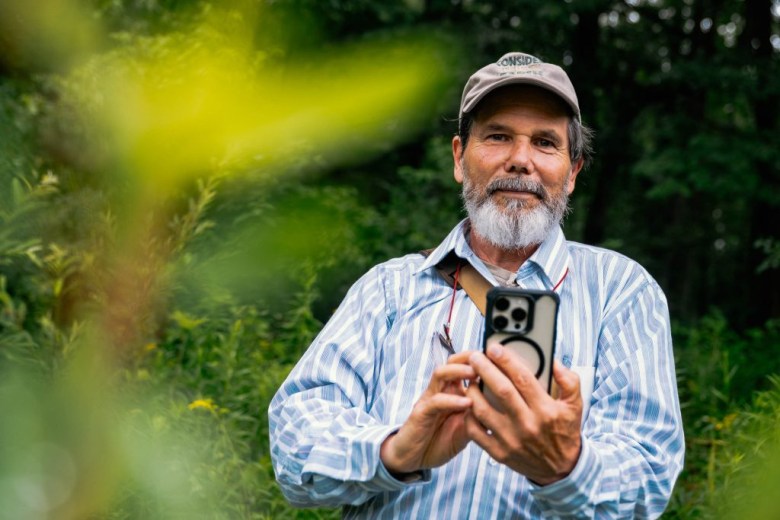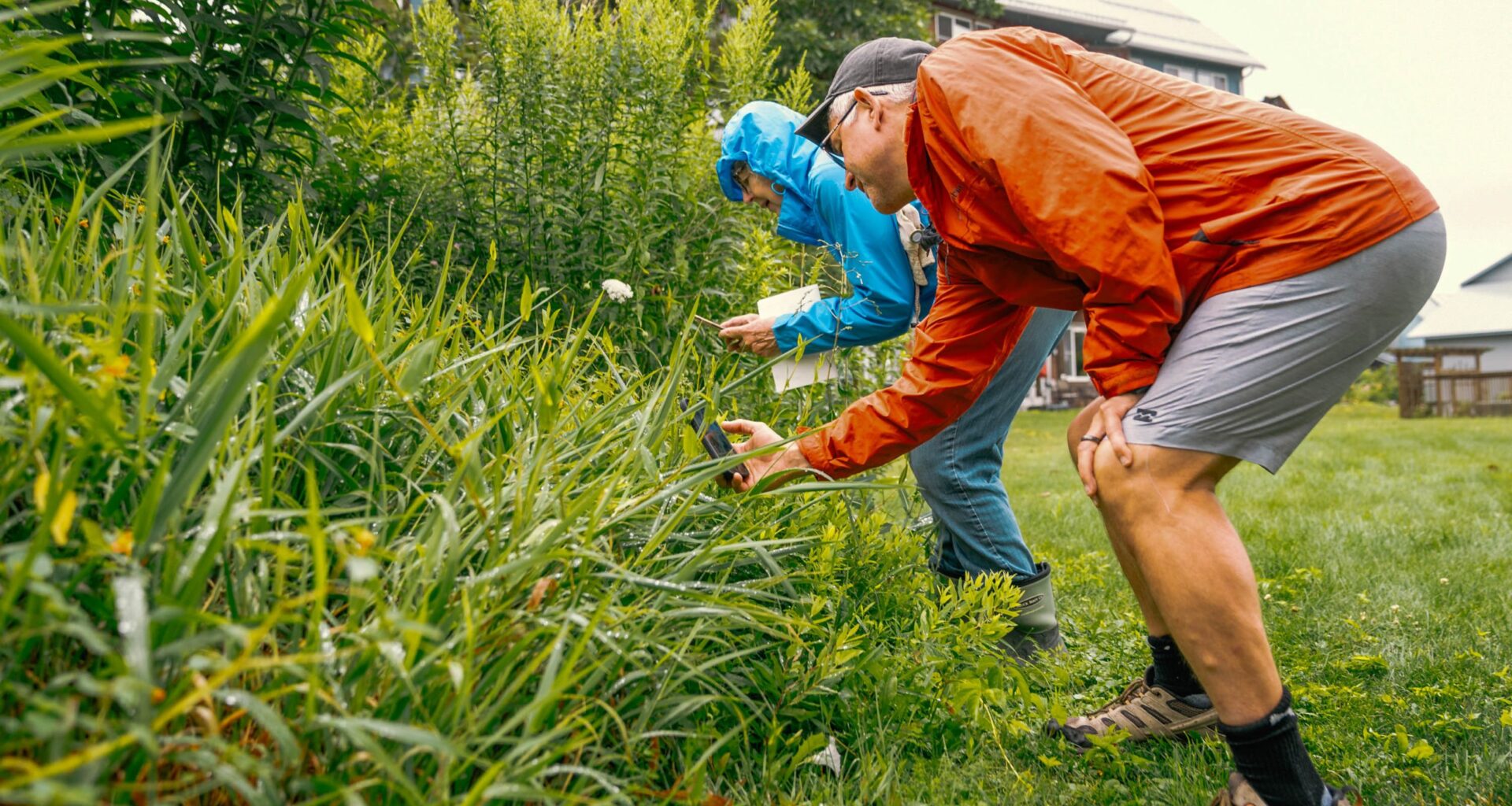ITHACA, N.Y. — There is no scarcity of wonder when surrounded by nature.
This weekend, a crowd of nature enthusiasts looked at the underside of a Goldenrod leaf through a magnifying glass and found a cluster of aphids, or small sap-sucking insects. Then they zoomed out and noticed this plant was the only one also carrying a steady march of ants.
The relationship between these two insects stumped them. Were the ants feeding on the aphids? A more experienced naturalist jumped into the conversation and suggested the ants were farming the aphids for honeydew, a sugary secretion produced by aphids.
This was one of the many observations of the natural world that the crowd made as they gathered at the Ithaca Ecovillage on Sunday to participate in this year’s summer BioBlitz.
The BioBlitz events, organized by the Paleontological Research Institute (PRI), bring the local community together to examine, discuss and document surrounding wildlife. Fitted in a rainbow of brightly colored raincoats to avoid getting wet from the early morning showers, attendees dared pull out their phones in the name of science.
 Frank Muller uses his phone to identify local flora. Casey Martin / Ithaca Voice
Frank Muller uses his phone to identify local flora. Casey Martin / Ithaca Voice
They took pictures of plants and animals and uploaded them to iNaturalist, the popular nature identification app. Frank Muller, a self-described amateur naturalist and resident of the Ecovillage, led the Sunday BioBlitz event, teaching attendees about the local wildlife and how to take the optimal photo for identification.
The goal, Ingrid Zabel said, is to get people to observe as many species as possible, while also trying to get them engaged in “being aware of what’s around them.” Zabel works as the climate change education manager at PRI.
This will be the institute’s fifth year hosting the BioBlitz, adding to a growing database of living species in Ithaca, Zabel said. The institute has now hosted 22 public BioBlitzes since its first in 2020.
“As things are changing, the climate’s changing, there’s more development, so habitats being lost, and we don’t necessarily get a comprehensive survey of what’s out there,” Zabel said.
The official start date of the BioBlitz was Friday and ended Monday, which allowed local schools and other afterschool programs to participate during the weekdays. The BioBlitz wasn’t confined to Ithaca either, rather spanning the whole Eastern Finger Lakes region. Any observation made within the bounds of this region was automatically submitted as part of the BioBlitz.
Despite the number of BioBlitz events held, five years is still too small for any changes to be noticed, Zabel said.
“You’d have to look over at least 30 years, I think, to say anything meaningful,” Zabel said.
The data can also be skewed by who participates in the blitzes. During their winter BioBlitz in January 2024, the database received a significant amount of insect submissions, which was surprising for Zabel. While this could mean that there were more insects that season, it is also likely that BioBlitz just included people who were particularly interested in insects, she said.
“So they’re not a really comprehensive view of all the life around us,” Zabel said. “But still, they are a snapshot of the biodiversity right now.”
During the five-day BioBlitz there were 2,946 observations spanning 1,211 species including Sensitive Ferns, Dog Vomit Slime Mold, Spring Peepers, Confused Haploa Moths and of course, Humans. Most observations were submitted from within Tompkins County, but some were recorded as far as Auburn, near the northern perimeter of the BioBlitz region.
Zabel said they’ll probably begin analyzing this data in a few years, but those interested in a more comprehensive breakdown of the recorded observations can download the datasets of every single BioBlitz hosted by PRI from their website.
Jen Myers, who works for Thrive, the Ithaca Ecovillage Education Center, said that this data would help the Ecovillage visualize the impact of their land stewardship practices, such as removing invasive species and planting natives.
Kristine Pinella recently moved to the Ecovillage from Allentown, Pennsylvania, hoping to be closer to nature. This weekend’s BioBlitz was her first in the area, although she did participate in one back in Pennsylvania, she said.
She said she’ll be keeping her eyes out for an Eastern Bluebird, which she hasn’t seen since her move.
Looking down instead of up, Muller reminded the rookie nature photographers about Broadleaf Plantain, a now-pervasive plant native to Eurasia. The plant, also known as the white man’s footprint because of its association with colonization, can be used as a healing poultice on wounds, poison ivy rashes, and bug bites.
While recording rare and interesting species is important, Zabel emphasized the importance of documenting the animals that might normally be taken for granted.
“When we work with groups, especially with the kids too, we also encourage them to observe the ordinary. Take pictures of those ordinary things like dandelions or maple trees,” she said.
Calum Avery also attended his first BioBlitz this weekend. He really wanted to find some salamanders Sunday.
The event allowed him to reconnect with nature more intentionally than if he’d just gone out on a hike, he said. It also allowed him to bear witness to the nature that’s still here today and create a snapshot of the natural world in a time when “the powers that be are not so interested in posterity at all,” he said.
He hopes his observations will stand as evidence that environmental deregulation for corporations did harm the environment, and that from it we can learn not just how systems form but also how they can collapse.
“It’s also good to remember that the stability of the environment is also the stability of our life support system,” he said.
If nothing else, Calum said it’s important to care about endangered species and the environment because of their intrinsic value as “beautiful, intricate, delicate things that are so resilient, but we are messing them up so totally.”
More stories like this

